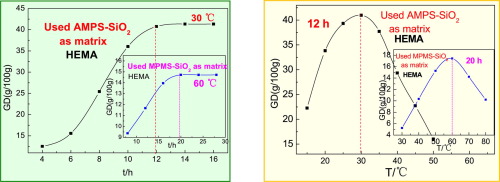当前位置:
X-MOL 学术
›
Eur. Polym. J.
›
论文详情
Our official English website, www.x-mol.net, welcomes your
feedback! (Note: you will need to create a separate account there.)
Characteristics and Advantages of Surface-initiated Graft-polymerization as a Way of “Grafting from” Method for Graft-polymerization of Functional Monomers on Solid Particles
European Polymer Journal ( IF 5.8 ) Pub Date : 2020-03-01 , DOI: 10.1016/j.eurpolymj.2020.109479 Ruikui Du , Baojiao Gao , Jiying Men , Fuqiang An
European Polymer Journal ( IF 5.8 ) Pub Date : 2020-03-01 , DOI: 10.1016/j.eurpolymj.2020.109479 Ruikui Du , Baojiao Gao , Jiying Men , Fuqiang An

|
Abstract In our researches done in recent years, a late-model graft-polymerization way as a means of “grafting from” method was founded, and it is the surface-initiated graft-polymerization. By using this new means, various functional monomers were smoothly grafted on solid particles, getting a variety of functional grafted particles. The key of this way lied on constituting a redox surface-initiating system at the interface between the particle and the solution, so that a great deal of free radicals would be produced on the surfaces of solid particles, and smoothly initiated the monomer to be graft-polymerized on solid particles. In this work, based on a lot of experimental data, the characteristics and advantages of the surface-initiated graft-polymerization way were further summarized, and the relevant mechanisms were analyzed. The system of NH2/S2O82− as a typical surface-initiating system was used, and the graft-polymerizations of three functional monomers, methacrylic acid (MAA), 2-hydroethyl methacrylate (HEMA) and N,N-dimethylaminoethyl methacrylate (DMAEMA), on silica gel particles were carried out. For comparison, the graft-polymerizations of the above three monomers were also performed by using “grafting through” method. The experimental results show that the graft-polymerizations by using surface-initiated graft-polymerization way can be carried out under mild conditions. More importantly, two distinct characteristics of the surface-initiated graft-polymerization way are displayed as compared with the “grafting through” method, and they are high grafting degree and rapid graft-polymerization rate. For example, for the graft-polymerization of HEMA, as the surface-initiated graft-polymerization way is used, the grafted degree of PHEMA on PHEMA/SiO2 particles at 30 °C in 12 h reaches up to 41 g/100 g, whereas when the “grafting though” method is adopted, the grafted degree of PHEMA on PHEMA/SiO2 particles at 60 °C in 20 h only reaches 15 g/100 g.
中文翻译:

表面引发接枝聚合作为功能单体在固体颗粒上接枝聚合的“接枝”方法的特点和优势
摘要 在我们近年来的研究中,建立了一种新型接枝聚合方式作为“接枝自”方法的手段,即表面引发接枝聚合。通过这种新手段,各种功能单体顺利地接枝在固体颗粒上,得到了多种功能接枝颗粒。这种方式的关键在于在颗粒与溶液的界面处构成氧化还原表面引发体系,使固体颗粒表面产生大量自由基,顺利引发接枝单体-在固体颗粒上聚合。本文在大量实验数据的基础上,进一步总结了表面引发接枝聚合方式的特点和优势,并分析了相关机理。使用NH2/S2O82−体系作为典型的表面引发体系,以及甲基丙烯酸(MAA)、甲基丙烯酸2-氢乙酯(HEMA)和甲基丙烯酸N,N-二甲氨基乙酯(DMAEMA)三种功能单体的接枝聚合, 在硅胶颗粒上进行。为了比较,上述三种单体的接枝聚合也采用“接枝贯通”的方法进行。实验结果表明,采用表面引发接枝聚合方式的接枝聚合反应可以在温和的条件下进行。更重要的是,与“通过接枝”方法相比,表面引发接枝聚合方式具有两个明显的特点,即接枝度高和接枝聚合速度快。例如,对于 HEMA 的接枝聚合,
更新日期:2020-03-01
中文翻译:

表面引发接枝聚合作为功能单体在固体颗粒上接枝聚合的“接枝”方法的特点和优势
摘要 在我们近年来的研究中,建立了一种新型接枝聚合方式作为“接枝自”方法的手段,即表面引发接枝聚合。通过这种新手段,各种功能单体顺利地接枝在固体颗粒上,得到了多种功能接枝颗粒。这种方式的关键在于在颗粒与溶液的界面处构成氧化还原表面引发体系,使固体颗粒表面产生大量自由基,顺利引发接枝单体-在固体颗粒上聚合。本文在大量实验数据的基础上,进一步总结了表面引发接枝聚合方式的特点和优势,并分析了相关机理。使用NH2/S2O82−体系作为典型的表面引发体系,以及甲基丙烯酸(MAA)、甲基丙烯酸2-氢乙酯(HEMA)和甲基丙烯酸N,N-二甲氨基乙酯(DMAEMA)三种功能单体的接枝聚合, 在硅胶颗粒上进行。为了比较,上述三种单体的接枝聚合也采用“接枝贯通”的方法进行。实验结果表明,采用表面引发接枝聚合方式的接枝聚合反应可以在温和的条件下进行。更重要的是,与“通过接枝”方法相比,表面引发接枝聚合方式具有两个明显的特点,即接枝度高和接枝聚合速度快。例如,对于 HEMA 的接枝聚合,











































 京公网安备 11010802027423号
京公网安备 11010802027423号